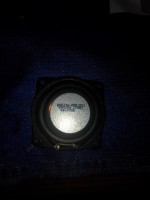Hi, I received a friend JBL charge 3 from a friend for repair. The problem is that one of the speakers cracks during stronger tones. I have diagnosed that the coil is probably damaged, my question is that I would like to replace this loudspeaker with a new one although during the search I can not find an identical 50 mm and 10 watt dimensions, at least that's what I read on the manufacturer's website. I can not get any information from the loudspeaker. If someone had a similar problem or found such a speaker, I would be extremely grateful for sending a link, best regards Tomek.




